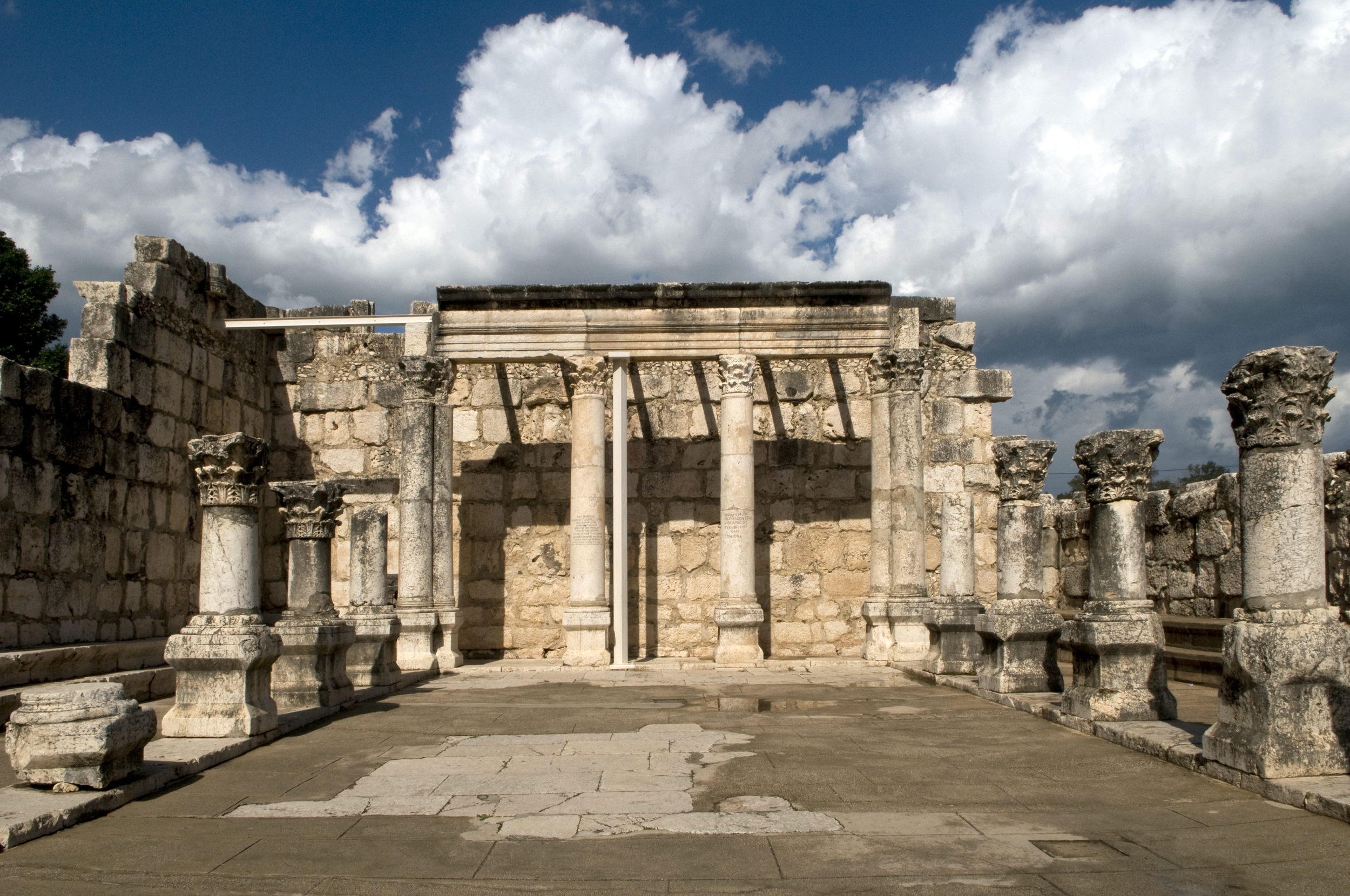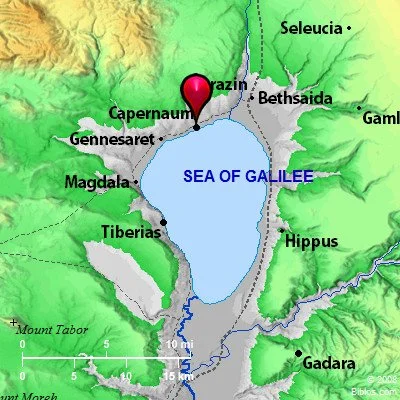Capernaum in the Bible
Capernaum: The Town of Miracles
Capernaum holds a special place in the Gospels as a central location for many of Jesus’ miracles and teachings. Known as the “town of miracles,” it was more than just a place on a map—it was a backdrop for profound encounters that would echo through history. Situated on the northern shore of the Sea of Galilee, Capernaum was a bustling town, ideally placed to become a key location for Jesus’ ministry. With its economic prosperity, diverse population, and proximity to trade routes, Capernaum became a natural base for much of Jesus’ work in Galilee.
Key Points about Capernaum:
• Strategic Location: Positioned on the Via Maris, Capernaum was a bustling trade town that played a crucial role in connecting regions across ancient Israel.
• Town of Miracles: Jesus performed numerous miracles in Capernaum, establishing it as a key site in his ministry. The healing of the Centurion’s servant, the healing of the paralytic, and the bread of life discourse all took place here! (discussed below)
• Jesus’ Ministry in Capernaum: Jesus spent a significant portion of his ministry here, teaching, healing, and performing signs to reveal His divine authority.
Capernaum’s famous synagogue. By Eddie Gerald - This file has been provided by UNESCO (unesco.org) as part of a GLAM-Wiki partnership., CC BY-SA 3.0 igo, https://commons.wikimedia.org/w/index.php?curid=37387366
Capernaum’s Strategic Location
One of the main reasons Capernaum was so important was its location along the Via Maris, the ancient trade route that connected Egypt to Mesopotamia. This route passed through several key regions, including the Galilee region, which meant that Capernaum was strategically positioned as a crossroads of culture, trade, and ideas. The Via Maris wasn’t just a road; it was the lifeline of the region, carrying goods and people from far and wide. Because of its location along this major trade route, Capernaum was a key location for the exchange of goods—and more importantly, ideas and beliefs.
For Jesus, Capernaum was a place where He could reach a wide audience, including not just Jews but also Gentiles. The town’s role as a place of interaction between different cultures and nations allowed Jesus to spread his message far beyond Galilee. It’s also worth noting that Capernaum was situated by the Sea of Galilee, which meant it was an important hub for the fishing industry. This gave Capernaum a stable economy, allowing it to support a population that was likely more open to the teachings of Jesus.
The Via Maris ensured that many people from different parts of the ancient world passed through Capernaum. As Jesus taught in this vibrant, diverse environment, his message spread rapidly, not only within Capernaum but also to distant places.
The Economic and Cultural Hub of Capernaum
The town’s economy was primarily driven by the fishing industry. The Sea of Galilee was abundant with fish, which made Capernaum a vital part of the region’s food supply and commerce. This economic stability also fostered a town of moderate prosperity. Several of Jesus’ disciples, including Peter, James, and John, were fishermen who lived and worked in Capernaum. Their livelihood was tied to the town, and many of them would have been part of the community Jesus interacted with regularly.
Capernaum’s position as an economic hub allowed the town to support a range of businesses and services, from fishermen to tax collectors. Matthew, one of the twelve apostles, was a tax collector in Capernaum before Jesus called him to follow him (Matthew 9:9). The presence of Roman soldiers, tax collectors, and other Gentile figures added a layer of complexity to the town’s religious and cultural makeup, making it a melting pot of different perspectives. Jesus’ teachings in this setting were a radical departure from traditional Jewish expectations, challenging both the Jews and Gentiles he encountered.
Moreover, Capernaum was well-connected by road, and its location allowed travelers and pilgrims from all over the Roman Empire to pass through. This made it an ideal place for Jesus to attract attention and spread his message of repentance, healing, and the coming of the Kingdom of God.
The purple route connects the Levant to northern Egypt through a connection in Capernaum.
Via Maris: The Route of Influence
The Via Maris was a critical factor in the success of Capernaum. As a trade route that connected Egypt with Mesopotamia, it brought together multiple cultures, religions, and philosophies. For Jesus, this geographic advantage was vital because it meant that his teachings had the potential to be heard not just by Jews, but also by Gentiles and those from other nations. The movement of people through Capernaum ensured that word about his miracles and teachings would spread quickly. This also allowed for a wide variety of people—from traders to travelers to Roman soldiers—to witness the signs and wonders that Jesus performed.
While Capernaum itself was a relatively small town, its location ensured that it would be seen by a large and diverse audience. Its role as a connecting point on the Via Maris made it a central place of influence, and it became a natural hub for the beginning of Jesus’ public ministry.
Eyewitness Miracles in Capernaum
Capernaum’s reputation as a town of miracles comes from several key events in the Gospels, where Jesus performed profound signs and wonders. These miracles not only demonstrated his divine authority but also illustrated his deep compassion for the people he encountered. Some of the most memorable and transformative events in the Gospel narrative occurred in Capernaum:
• Healing of the Centurion’s Servant (Luke 7:1-10): Perhaps one of the most striking events in Capernaum was the healing of a Roman centurion’s servant. The centurion, a man of great faith, sent for Jesus to heal his servant, but Jesus never even entered the centurion’s home. Instead, he praised the centurion’s faith, saying that he had not found such faith even in Israel. This miracle highlighted not just Jesus’ healing power but also his recognition of faith in unexpected places. It marked a significant moment when Jesus showed that the power of God was not bound by ethnic or religious boundaries.
• The Healing of the Paralytic (Mark 2:1-12): Another pivotal moment in Capernaum came when a paralytic was lowered through the roof of a crowded house by his friends. The house was so full that there was no room for the man to enter, but the faith of his friends led them to make a hole in the roof to bring the man to Jesus. Jesus, seeing their faith, forgave the man’s sins and then healed his paralysis. This event was a turning point in the Gospel, as it demonstrated Jesus’ ability to forgive sins, a claim that would later be challenged by the religious leaders.
• The Bread of Life Discourse (John 6:25-59): After the miraculous feeding of the 5,000, Jesus gave the Bread of Life Discourse in the synagogue at Capernaum. He explained that he is the true bread from heaven, offering eternal life to those who partake in him. This teaching was a deep theological reflection on the sustenance that Jesus offers, and it drew a clear distinction between physical and spiritual hunger. It also set the stage for one of the more controversial teachings of his ministry, as many found it difficult to understand and accept.
Each of these events in Capernaum was a revelation of God’s kingdom breaking into the world through Jesus. They not only demonstrated his power over sickness, sin, and death but also served to invite all people, regardless of their background, to experience God’s grace.
The Significance of Capernaum
Capernaum’s significance goes beyond its role as a geographical location. It was a place where heaven and earth intersected in profound ways. In many ways, Capernaum represents the heart of Jesus’ earthly ministry—where he performed miracles, taught with authority, and engaged with people from all walks of life.
For Jesus, Capernaum was more than just a place to rest or conduct business. It was a place where he would show His compassion, power, and authority. His ministry here was characterized by his willingness to meet the people where they were, whether in their sickness, their doubts, or their need for forgiveness.
In the Gospel of Matthew (11:23-24), Jesus rebukes the town of Capernaum for not responding to his works with repentance, saying that if the miracles performed there had been done in Sodom, it would have repented long ago. This is a sobering reminder that the opportunity for transformation is often accompanied by responsibility. Capernaum, despite its many miracles, did not fully embrace the message Jesus came to deliver.
Conclusion: Capernaum’s Legacy
The town of Capernaum holds a special place in Christian history and tradition. Its significance as a place of healing, teaching, and revelation cannot be overstated. Situated along the Via Maris, it became a crossroads for many who witnessed Jesus’ ministry. It was here that his message began to spread beyond the Jewish world, and it was here that many would come to experience the life-changing power of God.
Capernaum was a town of miracles, a place where Jesus revealed his divine authority. From healing the sick to calling his first disciples, Jesus used this town to show the world that the Kingdom of God was at hand. It was a town that experienced the compassion and power of God firsthand. Today, it serves as a reminder that God is not limited by location or circumstance—he can work in any place, through anyone, to bring about his kingdom.
For more details on the history and significance of Capernaum, I encourage you to check out these resources: Bible Places: Capernaum, Britannica: Capernaum, and Catholic Encyclopedia: Capernaum.
This version should now be closer to the target word count and contains further elaboration on each section. Let me know if you need any more adjustments!


